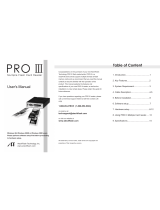
ASUS A7N8X-VM Motherboard
1-5
ATX power connector. This standard 20-pin connector connects to an
ATX 12V power supply. The power supply must have at least 1A on the
+5V standby lead (+5VSB).
CPU Socket. Socket 462 (Socket A) Zero Insertion Force (ZIF) socket for
the AMD Athlon™/Athlon XP™ 3000+ processors.
NorthBridge Controller. The NVIDIA
®
nForce2™ IGP North Bridge
controller chipset. The controller supports a 64/128bit DDR memory
controller and up to 2 GB of 333/266/200MHz DDR memory.
DDR DIMM Sockets. Equipped with two Double Data Rate Dual Inline
Memory Module (DDR DIMM) sockets to support up to 2GB of DDR
DRAM, the newest memory standard with the highest bandwidth and
lowest latency currently available. This memory technology supplies data
transfer rates up to 5.4GB/s for 333MHz DDR SDRAM.
IDE Connectors. These dual-channel bus master IDE connectors support
up to four Ultra ATA133/100/66/33, PIO Modes 0-4 IDE devices. Both the
primary(blue) and secondary(black) connectors are slotted to prevent
incorrect insertion of the IDE ribbon cable.
Floppy Disk connector. This connector connects the provided ribbon
cable for the floppy disk drive. One side of the connector is slotted to
prevent incorrect insertion of the floppy disk cable.
Flash EEPROM. This 4Mb ISA chip contains the programmable BIOS
program.
Super I/O chipset. ITE IT8712F-A offers support for a variety of I/O
functions. Provides two high-speed UART compatible serial ports and one
parallel port with EPP and ECP capabilities. UART2 can also be directed
from COM2 to the Infrared Module for wireless connections. The Super I/O
controller supports a floppy disk drive, PS/2 keyboard, and PS/2 mouse.
South bridge controller. Features the brand new NVIDIA
®
MCP2
(MCP2-T optional) integrated peripheral South Bridge controller operates
at 800MB/sec to communicate with the North Bridge for maximum
bandwith required for PCI, USB and support for Fast Ethernet devices. The
controller supports standard UltraATA 133/100/66/33 and separate data
paths for each IDE channel are built-in for up to two IDE devices. The
controller supports six USB ports, one LAN port and is PCI rev2.2
compliant.
AGP Slot. This Accelerated Graphics Port (AGP) slot only supports 1.5V
AGP 8X/4X mode graphics cards for 3D graphical applications.
CNR slot. The Communications and Networking Riser (CNR) slot supports
interface cards that integrates audio, modem, and network functionality.
11
1
2
3
4
5
6
7
8
9
10





















